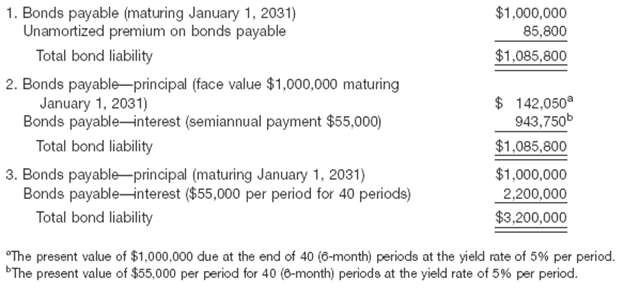(Bond Theory: Balance Sheet Presentations, Interest Rate, Premium) On January 1, 2011, Nichols Company issued for $1,085,800...
Question:
(Bond Theory: Balance Sheet Presentations, Interest Rate, Premium) On January 1, 2011, Nichols Company issued for $1,085,800 its 20-year, 11% bonds that have a maturity value of $1,000,000 and pay interest semiannually on January 1 and July 1. Bond issue costs were not material in amount.
Below are three presentations of the long-term liability section of the balance sheet that might be used for these bonds at the issue date.
(a) Discuss the conceptual merit(s) of each of the date-of-issue balance sheet presentations shown above for these bonds.
(b) Explain why investors would pay $1,085,800 for bonds that have a maturity value of only $1,000,000.
(c) Assuming that a discount rate is needed to compute the carrying value of the obligations arising from a bond issue at any date during the life of the bonds, discuss the conceptual merit(s) of using for this purpose:
(1) The coupon or nominal rate.
(2) The effective or yield rate at date of issue.
(d) If the obligations arising from these bonds are to be carried at their present value computed by means of the current market rate of interest, how would the bond valuation at dates subsequent to the date of issue is affected by an increase or a decrease in the market rate of interest?

Balance sheet is a statement of the financial position of a business that list all the assets, liabilities, and owner’s equity and shareholder’s equity at a particular point of time. A balance sheet is also called as a “statement of financial... Coupon
A coupon or coupon payment is the annual interest rate paid on a bond, expressed as a percentage of the face value and paid from issue date until maturity. Coupons are usually referred to in terms of the coupon rate (the sum of coupons paid in a... Discount Rate
Depending upon the context, the discount rate has two different definitions and usages. First, the discount rate refers to the interest rate charged to the commercial banks and other financial institutions for the loans they take from the Federal... Maturity
Maturity is the date on which the life of a transaction or financial instrument ends, after which it must either be renewed, or it will cease to exist. The term is commonly used for deposits, foreign exchange spot, and forward transactions, interest...
Step by Step Answer:

Intermediate Accounting
ISBN: 978-0470423684
13th Edition
Authors: Donald E. Kieso, Jerry J. Weygandt, And Terry D. Warfield





